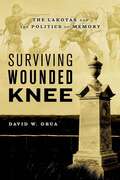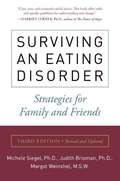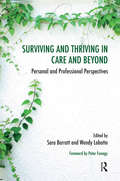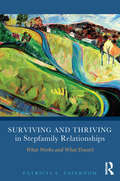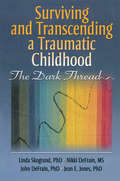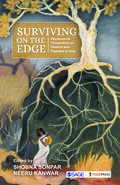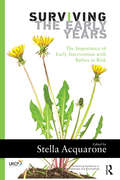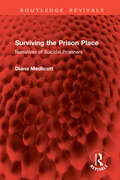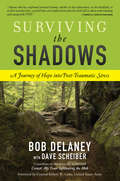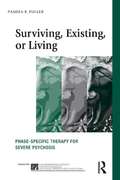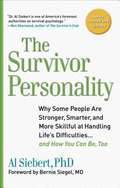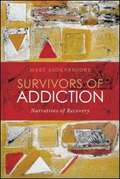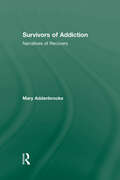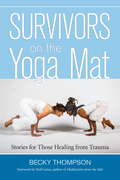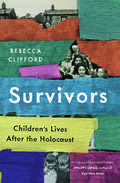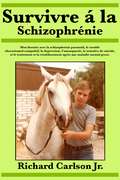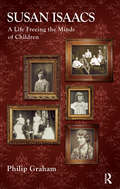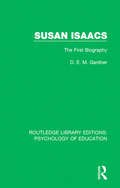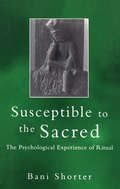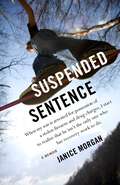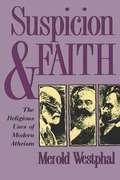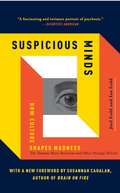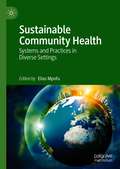- Table View
- List View
Surviving Wounded Knee: The Lakotas and the Politics of Memory
by David W. GruaOn December 29, 1890, the U.S. Seventh Cavalry killed more than two hundred Lakota Ghost Dancers- including men, women, and children-at Wounded Knee Creek, South Dakota. After the work of death ceased at Wounded Knee, the work of memory commenced. For the US Army and some whites, Wounded Knee was the site where a heroic victory was achieved against the fanatical Chief Big Foot and his treacherous Ghost Dancers and where the struggle between civilization and savagery for North America came to an end. For other whites, it was a stain on the national conscience, a leading example of America's dishonorable dealings with Native peoples. For Lakota survivors it was the site of a horrific massacre of a peacemaking chief and his people, and where the United States violated its treaty promises and slaughtered innocents. <p><p>Historian David Grua argues that Wounded Knee serves as a window into larger debates over how the United States' conquest of the indigenous peoples should be remembered. During the five decades after Wounded Knee, the survivors pursued historical justice in the form of compensation, in accordance with traditional Lakota conflict resolution practices and treaty provisions that required compensation for past wrongs. The survivors engaged in the politics of memory by preparing compensation claims, erecting a monument "in memory of the Chief Big Foot massacre" at the mass grave on the Pine Ridge Reservation, by dictating accounts to sympathetic whites, and by testifying before the U.S. Congress in the 1930s in support of a bill intended to "liquidate the liability" of the United States for Wounded Knee. Despite the bill's failure, the survivors' prolonged pursuit of justice laid the foundation for later activists who would draw upon the memorial significance of Wounded Knee to promote indigenous sovereignty. <p><p>Published on the 125th anniversary of this controversial event, Surviving Wounded Knee examines the Lakota survivors' half-century pursuit of justice and points to lingering questions about the United States' willingness to address the liabilities of Indian conquest.
Surviving an Eating Disorder, Third Edition
by Margot Weinshel Michele Siegel Judith BrismanSurviving an Eating Disorder has become a classic since it was first published in 1988. It was one of the first books to offer effective support and solutions for family, friends, and all others who are the "silent sufferers" of eating disorders. This updated and revised edition provides the latest information on how parents, spouses, friends, and professionals can thoughtfully determine the right course of action in their individual situations. With its combination of information, insight, case examples, and practical strategies, Surviving an Eating Disorder opens the way to new growth and helpful solutions in your relationship with your loved one.
Surviving an Eating Disorder: New Perspectives and Strategies for Family and Friends
by Margot Weinshel Michele Siegel Judith BrismanFrom the book: The first book of its kind, Surviving an Eating Disorder is an inspiring yet realistic guide written expressly for parents, spouses, friends, relatives, and all others who are the "silent sufferers" of anorexia, bulimia, and compulsive overeating. Whether you've just begun to suspect a problem or have been facing the frightening reality of a serious disorder for some time, this reassuring book will help you to overcome feelings of confusion, helplessness, and anger and to take new actions that will encourage the recovery process. The authors, three leading experts in the field, explain what you can expect from the eating-disordered person--and yourself---and what kind of support is available. Drawing on the authors' extensive experience in counseling individuals, groups, and families, and illustrated throughout with vivid case examples, Surviving an Eating Disorder will help answer all your questions, large and small: Why is this happening? Can I keep sweets in the house? What do I say when she asks if she looks fat? How can I help him with his diet? Should I suggest therapy? Will things get better? In Part I, "Gaining Perspective," the authors discuss the psychological components of eating disorders as well as the family contexts in which they develop. Part II, "Confronting the Problem," offers guidance for bringing the problem out into the open, getting the person into treatment, and coping with the possibility of anger and denial. In Part III, "Using New Strategies," the authors show how the situation can be made better--now--by disengaging from the eating disorder (with practical suggestions for handling such daily issues as mealtimes, messy bathrooms, money, and requests for advice) while reestablishing a relationship with the eating disordered person based on issues other than food and weight. The guide concludes with names and addresses of national organizations and a list of suggested readings.
Surviving and Thriving in Care and Beyond: Personal and Professional Perspectives (The Systemic Thinking and Practice Series)
by Sara BarrattThis is a book about children who have to grow up apart from their biological parents, the impact of this on their lives and on those who look after them, and how we can respond to the challenges this poses in order that they can grow and develop in healthy directions. It provides a systemic framework to describe working with children and adults who are or have been in care or adopted, as well as working with their adoptive parents and carers, highlighting their own narratives and those of professionals working with them. The authors have tried to make space for multiple voices to speak and describe aspects of the care system and life beyond. There are contributions from those who have been brought up away from their biological parents, their adoptive parents and foster or kinship carers. There are also contributions from researchers and professionals with expertise in working with children in substitute care, who describe their theoretical and clinical approaches, privileging the voices of those with whom they work.
Surviving and Thriving in Stepfamily Relationships: What Works and What Doesn't
by Patricia L. PapernowSurviving and Thriving in Stepfamily Relationships draws on current research, a wide variety of clinical modalities, and thirty years of clinical work with stepfamily members to describe the special challenges stepfamilies face. The book presents the concept of "stepfamily architecture" and the five challenges it creates, and delineates three different levels of strategies—psychoeducation, building interpersonal skills, and intrapsychic work—for meeting those challenges in dozens of different settings. The model is designed to be useful both to stepfamily members themselves and to a wide variety of practitioners, from a highly trained clinician who needs to know how and when to work on all three levels, to a school counselor or clergy person who may work on the first two levels but refer out for level three. It will also be useful to educators, judges, mediators, lawyers and medical personnel who will practice on the first level, but need to understand the other two to guide their work.
Surviving and Transcending a Traumatic Childhood: The Dark Thread
by Linda Skogrand Jean Jones John DeFrain Nikki DeFrainA powerful guide to transcending childhood trauma—from the people who’ve done itIt’s like a dark thread woven through a piece of cloth: You can’t pull it out without unraveling the whole thing. And it shows up here and there among all the other threads.Surviving and Transcending a Traumatic Childhood: The Dark Thread weaves together 90 stories of survival to create a silver lining of hope for those struggling to heal from childhood trauma. This unique book documents the endless challenges facing children and adults who have been subjected to physical, emotional, and psychological abuse, and examines the proactive coping strategies that have made their recoveries a success. Each poignant story reveals an amazing capacity for growth and an ability to adapt emotionally that offers a positive spirit to others suffering abuse.Surviving and Transcending a Traumatic Childhood: The Dark Thread examines how 90 people who have experienced childhood trauma and abuse have been able to rise above the suffering to not only endure, but prevail. In their own words, trauma survivors discuss what happened to them as children and the process they went through to become healthy, happy adults. Their stories are heartfelt, heartbreaking, and sometimes surprising in the variety of traumatic experiences, the intensity of the stress, and the number of people who were forced to deal with multiple issues in childhood, including sexual and physical abuse, alcoholism, neglect, and violence. The stories told in Surviving and Transcending a Traumatic Childhood: The Dark Thread explore: when the trauma began common feelings associated with trauma therapy and support groups getting married escaping abuse the role of religion and spirituality significant people who provided help types of homes where abuse occurred the positive effects of surviving trauma school life patterns of survival and much moreSurviving and Transcending a Traumatic Childhood: The Dark Thread also includes a list of resources that might be helpful to those in the process of transcending trauma and a self-study guide for developing a deeper understanding of the healing process.
Surviving on the Edge: Psychosocial Perspectives on Violence and Prejudice in India
by Shobna Sonpar and Neeru KanwarWritten by psychologists and others using a psychosocial lens, Surviving on the Edge looks at family, gender, disability and ethnicity in order to better understand prejudice and social violence. The book includes a range of essays—theoretical, narrative accounts and case studies—which question established assumptions as to how violence relates to categories of gender, family, disability and trauma. It also considers the impact of social violence and possible interventions to address trauma at both the individual and collective levels. The impact of prejudice and violence is on one hand painful and tragic. But on the other, there is abundant evidence of resistance and resilience. Several illuminating examples of work on the ground demonstrate the range of interventions possible. This book is a valuable addition to the fledgling corpus of work that uses a psychosocial perspective to examine social problems, the impact of these on mental health and the interventions possible.
Surviving the Early Years: The Importance of Early Intervention with Babies at Risk (The\united Kingdom Council For Psychotherapy Ser.)
by Stella AcquaroneThis book is about the hope underlying the ability to survive the early years. Coleridge's The Rime of the Ancient Mariner is both metaphor and framework of the despair and hopelessness that some babies and parents experience in their efforts to hold on and go through difficult circumstances. Their early experiences are not voyages "into a sunny and cheerful sea": some are years-long voyages into horror and weariness - babies born into difficult families, into countries in difficulties or into difficult circumstances. Some babies born into difficulties are pretty much alone because their mothers might be too ill to look after them, and nurses are too busy to fulfil the maternal function other than changing and feeding them. They may have been born in war zones, or in prisons, or have been in intensive neonatal premature units. Unlike mothers who recall the early years with their babies as a dance of understanding and development, other carers don't recall hearing the music at all.
Surviving the Prison Place: Narratives of Suicidal Prisoners (Routledge Revivals)
by Diana MedlicottSuicide in prison is a growing problem across the developed world. Originally published in 2001, this book sets out to enlarge understanding of the complexities of suicidal feelings and of the part played by some inalienable features of prison life. It does this by presenting and analysing prisoners’ accounts of their most intimate responses to the deprivations of prison, in particular the stringent control and management of their personal time and space. These accounts show, in more graphic form than previous literature, the depth of suffering as well as the range of creative responses produced in prisoners through interaction with the prison environment. Prisoners themselves have enormous need for more humane and interactive management of the problem, and their accounts show clearly how prisoner expertise could be utilised in profoundly significant ways. This book will be of interest to all who research, live or work in prison, as well as to students and practitioners in criminology, penology, criminal justice, sociology, psychology, psychiatry and health.
Surviving the Shadows: A Journey of Hope into Post-traumatic Stress
by Bob Delaney Dave ScheiberSurviving the Shadows is an uplifting journey through powerful and inspiring stories-marked by perseverance and personal courage-of an array of people who have suffered directly or indirectly from PTSD. Along the way Delaney introduces readers to medical experts who have developed ground-breaking methods in dealing with the disorder. And he explains the importance and effectiveness of peer-to-peer therapy as a crucial first step in the healing process-an approach for which he has won wide-spread support through his close work with military groups, law enforcement, and emergency services.
Surviving, Existing, or Living: Phase-specific therapy for severe psychosis (The International Society for Psychological and Social Approaches to Psychosis Book Series)
by Pamela R. FullerFor professionals working with people who experience severe psychosis, increasing empirical evidence for the benefits of psychotherapy for psychosis has been especially welcome. Given the limitations of medication-only approaches and the need for an expanded perspective, including for those diagnosed with schizophrenia, Surviving, Existing, or Living takes a fresh look at severe psychosis, offering a heuristic model for understanding psychosis along a continuum of severity, from the extreme experience of acutely impairing psychosis to a more enriched life experience. Pamela Fuller emphasizes that facilitating recovery from psychosis requires appropriately and effectively matching the type and timing of interventions to client readiness and capabilities. The need to consider each individual according to which of three primary issues/phases preoccupy the person with psychosis is essential for tailoring treatment. She identifies these phases as: Surviving Phase – preoccupation with survival Existing Phase – preoccupation with restriction of life experiences in order to cope Living Phase – preoccupation with quality of life and relationships Surviving, Existing, or Living examines the rationale for these three phases, and provides details of phase-specific treatment interventions as well as a 'how to' guide for facilitating engagement and for determining 'what to do when,' including with those experiencing acute, severe psychosis. Rich clinical case examples are provided to highlight concepts and the types of interventions. Trauma-specific and group interventions for psychosis are also described, as well as ways to foster resilience in the professional who works with individuals with psychosis. Surviving, Existing, or Living offers a detailed guide to help individuals experiencing psychosis move from suffering to recovery, beyond surviving or existing toward more fully living. The book will be essential reading for professionals in the fields of psychology, psychiatry, counseling, medicine, social work, nursing, occupational, recreational, and vocational therapies, experience-based experts, and students.
Survivor Personality
by Al Siebert"As a survivor, I am impressed with this valuable tool for those who look for hope in hopelessness. Dr. Siebert provides a practical guide for anyone who chooses to be a survivor rather than a victim. "-Edith Eva Eger, Ph. d. , Auschwitz survivor.
Survivors Of Addiction: Narratives Of Recovery
by Mary AddenbrookeAddiction is something that affects many different people from all walks of life and can be difficult for a therapist to treat, and the client to conquer. In this book fifteen people who have formerly had serious addictions speak about their experiences. Survivors of Addiction draws on first-hand narratives to provide an overview of how and why people become addicted, and explores what happens after the addiction is left behind. Divided into four sections it covers: being caught up in addiction how and why users stop being addicted the early days after surviving addiction long-term outcomes. By considering psychodynamic and Jungian perspectives as well as the clinical vignettes, this book examines the process of recovery from addiction. It will be key reading for therapists, clinicians and healthcare workers who encounter addictions in their day to day professions and will also be of great interest to those who are, or have been addicted, and their families.
Survivors of Addiction: Narratives of Recovery
by Mary AddenbrookeAddiction is something that affects many different people from all walks of life and can be difficult for a therapist to treat, and the client to conquer. In this book fifteen people who have formerly had serious addictions speak about their experiences. Survivors of Addiction draws on first-hand narratives to provide an overview of how and why people become addicted, and explores what happens after the addiction is left behind. Divided into four sections it covers: being caught up in addiction how and why users stop being addicted the early days after surviving addiction long-term outcomes. By considering psychodynamic and Jungian perspectives as well as the clinical vignettes, this book examines the process of recovery from addiction. It will be key reading for therapists, clinicians and healthcare workers who encounter addictions in their day to day professions and will also be of great interest to those who are, or have been addicted, and their families.
Survivors on the Yoga Mat
by Becky Thompson Rolf GatesAn inspiring collection of essays that reveal the healing power of yoga, Survivors on the Yoga Mat is an ideal companion for trauma survivors and yoga teachers alike. Weaving together stories from her classes, travels, and workshops, author Becky Thompson shows the brave and unique ways that survivors approach yoga: the creative ways that they practice, the challenges they face, and the transformative experiences they discover. Thompson skillfully draws connections between yoga and social-justice activism, demonstrating how a trauma-sensitive approach to yoga makes room for all of us--across race, class, gender, religion and nationality. Survivors on the Yoga Mat offers stories, reflections, and meditations for people who are healing from a wide range of traumas--sexual abuse, accidents, child abuse, war, illnesses, incarceration, and other injuries. The book consists of 90 true stories--alternately funny, surprising, and irreverent--that together provide a roadmap for survivors on their journey to wholeness. Organized into six sections, the book explores the challenges of beginning a yoga practice; the unique strengths of trauma survivors; the circuitous path of healing; yoga's value as a lifelong practice; the special role of teachers; and the potential of yoga as an avenue for activism. Also included is a description of Pantajali's Eight Limbs of Yoga, a list of resources, an appendix explaining the different styles of yoga, and a beautiful photo glossary with over 100 photos of the yoga postures mentioned in the book.
Survivors: Children's Lives After the Holocaust
by Rebecca CliffordTold for the first time from their perspective, the story of children who survived the chaos and trauma of the Holocaust How can we make sense of our lives when we do not know where we come from? This was a pressing question for the youngest survivors of the Holocaust, whose prewar memories were vague or nonexistent. In this beautifully written account, Rebecca Clifford follows the lives of one hundred Jewish children out of the ruins of conflict through their adulthood and into old age. Drawing on archives and interviews, Clifford charts the experiences of these child survivors and those who cared for them—as well as those who studied them, such as Anna Freud. Survivors explores the aftermath of the Holocaust in the long term, and reveals how these children—often branded &“the lucky ones&”—had to struggle to be able to call themselves &“survivors&” at all. Challenging our assumptions about trauma, Clifford&’s powerful and surprising narrative helps us understand what it was like living after, and living with, childhoods marked by rupture and loss.
Survivre à la schizophrénie
by Richard Carlson Jr. Berenice Arrieta CortésRichard Carlson Jr. a été diagnostiqué avec la schizophrénie paranoïde quand il avait vingt et un ans. Sa maladie s'est manifestée pour la première fois lorsqu'il était adolescent. La psychiatrie moderne a grandement échoué Richard pendant plus d'une décennie. Puis, après un incident impliquant la police, il a vraiment compris que son diagnostic était réel, et a finalement commencé le long processus de récupération. Plus de dix ans plus tard, sa vie est grandement améliorée. Au cours de son traitement, Richard a également guéri de la dépression, du trouble obsessionnel-compulsif et de la léthargie. Ne laissez pas ce qui est arrivé à Richard vous arriver, à un être cher ou à un patient souffrant de maladie mentale grave. Soyez toujours honnêtes les uns avec les autres et avec votre psychiatre.
Susan Isaacs: A Life Freeing the Minds of Children
by Philip GrahamThis biography provides a critical account of the life and work of Susan Isaacs (1885-1948). This educationist, a pioneer of child-centred education in Britain was also an early and historically important child psychoanalyst. She is described in the Oxford Dictionary of National Biography as the greatest influence on British education in the twentieth century. Yet she is virtually unknown in both educational and psychoanalytic circles. When Melanie Klein was threatened with expulsion from the British Psychoanalytic Society she was by far her most powerful advocate and thus played a major role in determining the direction of British psychoanalysis from the 1940s onwards. This book provides an account of her life and contains much intimate material about her childhood, her marriage and her work that was previously unknown. It gives a fascinating insight into many facets of her life and concludes with an appraisal of her impact on the worlds of education and psychoanalysis.
Susan Isaacs: The First Biography (Routledge Library Editions: Psychology of Education)
by D.E.M. GardnerOriginally published in 1969, this is the first biography of Susan Isaacs, the first attempt to estimate her incalculable contribution to the theory and practice of the education of young children. As a pioneer of new teaching methods, Susan Isaacs will be remembered mainly for her work at the Malting House School in Cambridge in the 1920s, and her contribution was such that in 1933 the Department of Child Development at the University of London, Institute of Education was specially created for her; she was Head of the Department until 1943. But Susan Isaacs was also a psychoanalyst, and D.W. Winnicott in his Foreword refers to the time when he was supplying cases for her child analysis training: ‘I watched with interest her sensitive management of the total family situation, a difficult thing when one is engaged in learning while carrying out a psycho-analytic treatment involving daily sessions over years.’ D.E.M. Gardner, who was a close friend as well as student of Susan Isaacs, begins by describing Susan’s childhood in a Lancashire cotton town, and throughout the book she helps us to feel the force of Susan’s personality and intellect – ‘she was a truly great person, one who has had a tremendous influence for good on the attitude of parents and of teachers to the children in their care’.
Susceptible to the Sacred: The Psychological Experience of Ritual
by Bani ShorterIn Susceptible to the Sacred, Bani Shorter, a well-known Jungian analyst, examines the psychological experience of ritual in contemporary life and how this promotes awareness of the individual's natural potential. Basing her book on live material, she investigates, with great sensitivity, how people perceive the sacred and use ritual in their search for purpose, motivation and transformation.
Suspended Sentence: A Memoir
by Janice MorganWhen Janice Morgan, a divorced college professor living in a small town in Kentucky, learns that her son has been arrested for possession of a stolen firearm and drug charges, she feels like she&’s living a nightmare. Dylan&’s turbulent period as a college student in Cincinnati before this should have warned her, but it&’s only now that she realizes how far he has drifted into substance abuse and addiction. As Dylan passes through the judicial system and eventually receives a diversion to drug court, Morgan breathes a sigh of relief—only to find that she, too, has been sentenced right along with him. In the months to follow, she leads a double life: part of it on campus, the rest embarking upon what she calls &“rescue missions&” to help Dylan stay in the program. But resilience, dark humor, and extreme parenting can only carry you so far. Eventually, Morgan discovers that she needs to gain a deeper understanding of the bipolar and addiction issues her son is dealing with. Will each of them be able to learn fast enough to face these complexities in their lives? Clearly, Dylan isn&’t the only one who has recovery work to do.
Suspicion and Faith: The Religious Uses of Modern Atheism
by Merold WestphalMarx, Nietzche, and Freud are among the most influential of modern atheists. The distinctive feature of their challenge to theistic and specifically Christian belief is expressed by Paul Ricoeur when he calls them the "masters of suspicion." While skepticism directs its critique to the truth or evidential basis of belief, suspicion asks two different, intimately intertwined questions: what are the motives that lead to this belief? and what function does it play, what work does it do for the individuals and communities that adopt it. <P><P>What suspicion suspects is that the survival value of religious beliefs depends on satisfying desires and interests that the believing soul and the believing community are not eager to acknowledge because they violate the values they profess, as when, for example, talk about justice is a mask for deep-seated resentment and the desire for revenge. For this reason, the hermeneutics of suspicion is a theory, or group of theories, of self-deception: ideology critique in Marx, genealogy in Nietzsche, and psychoanalysis in Freud. <P><P>Suspicion and Faith argues that the appropriate religious response ("the religious uses of modern atheism") to these critiques is not to try to refute or deflect them, but rather to acknowledge their force in a process of self-examination--and this for two reasons. First, while these critiques are not, as Marx, Nietzsche, and Freud tend to suppose.
Suspicious Minds
by Joel Gold Ian GoldWhat if you woke up with the alarming suspicion that you were being watched?One day in 2003, a patient unlike any other that Dr. Joel Gold had seen before was admitted to his unit at Bellevue Hospital. This man claimed he was being filmed constantly and that his life was being broadcast around the world like The Truman Show--the 1998 film depicting a man who is unknowingly living out his life as the star of a popular soap opera. Over the next few years, Dr. Gold saw a number of patients suffering from what he and his brother, Dr. Ian Gold, began calling the "Truman Show delusion," launching them on a quest to understand the nature of this particular phenomenon, of delusions more generally, and of madness itself. The current view of delusions is that they are the result of biology gone awry, of neurons in the brain misfiring. In contrast, the Golds argue that delusions are the result of the interaction between the brain and the social world. By exploring the major categories of delusion through fascinating case studies and marshaling the latest research in schizophrenia, the brothers reveal the role of culture and the social world in the development of psychosis--delusions in particular. Suspicious Minds presents a groundbreaking new vision of just how dramatically our surroundings can influence our brains.
Suspicious Minds: How Culture Shapes Madness
by Joel Gold Ian GoldCombining extraordinary true stories with the latest research, Joel and Ian Gold take us on a wild journey through the delusional brain to explore the intersection of neuroscience, biology, and culture.<P> Mr. A. was admitted to Dr. Joel Gold’s inpatient unit at Bellevue Hospital in 2002. He was, he said, being filmed constantly, and his life was being broadcast around the world “like The Truman Show”—the 1998 film depicting a man who is unknowingly living out his life as the star of a popular soap opera. Over the next few years, Gold saw a number of patients suffering from what he and his brother, Dr. Ian Gold, began calling the “Truman Show Delusion,” launching them on a quest to understand the nature of this particular phenomenon, of delusions more generally, and the nature of madness itself.<P> The current view of delusions is that they are the result of biology gone awry, of neurons in the brain misfiring. In contrast, the Golds argue, delusions are in fact the result of the interaction between the brain and the social world. By exploring the major categories of delusion via fascinating case studies and marshaling the latest research in schizophrenia, the brothers reveal the role of culture and the social world in the development of psychosis, notably delusions. The result is a groundbreaking new direction for thinking about the interaction of the brain and the world around us.<P> Sure to appeal to those who admire the work of Oliver Sacks, Steven Pinker, and Antonio Damasio, Suspicious Minds presents a fascinating study about just how dramatically our surroundings can influence our brains.<P>
Sustainable Community Health: Systems and Practices in Diverse Settings
by Elias MpofuApplying a trans-disciplinary approach, this book provides a comprehensive, research-based guide to understanding, implementing, and strengthening sustainable community health in diverse international settings. By examining the interdependence of environmental, economic, public health, community wellbeing and development factors, the authors address the systemic factors impacting health disparities, inequality and social justice issues. The book analyzes strategies based on a partnership view of health, in which communities determine their health and wellness working alongside local, state and federal health agencies. Crucially, it demonstrates that communities are themselves health systems and their wellbeing capabilities affect the health of individuals and the collective alike. It identifies health indicators and tools that communities and policy makers can utilize to sustain truly inclusive health systems. This book offers a unique resource for researchers and practitioners working across psychology, mental health, rehabilitation, public health, epidemiology, social policy, healthcare and allied health.
